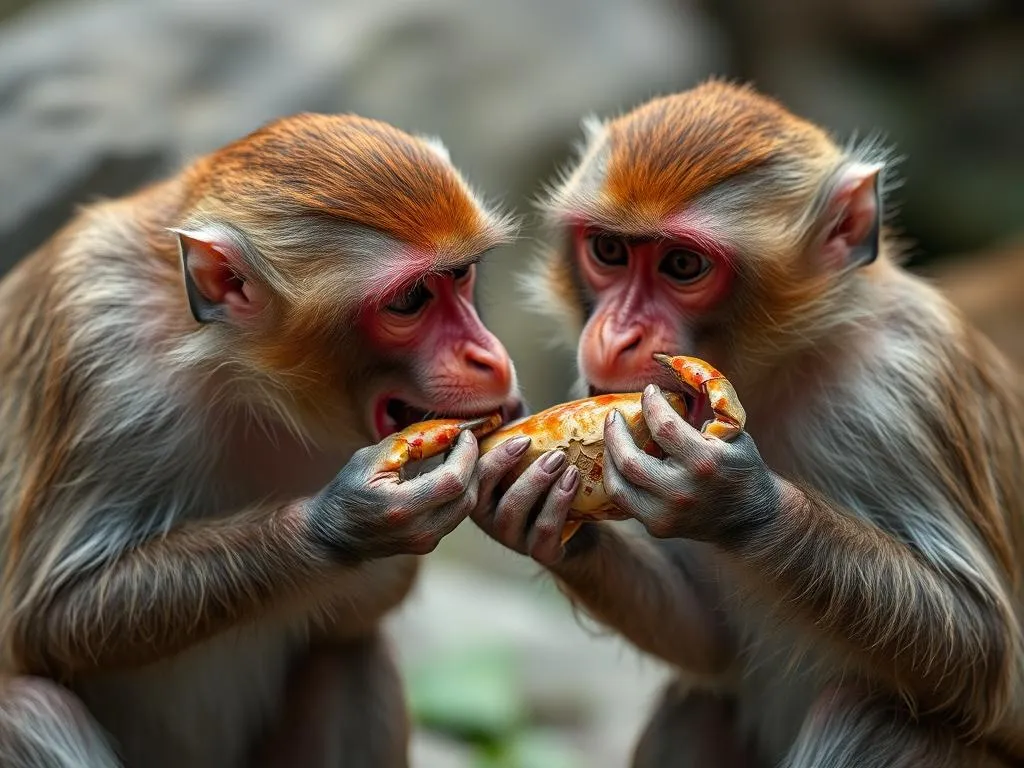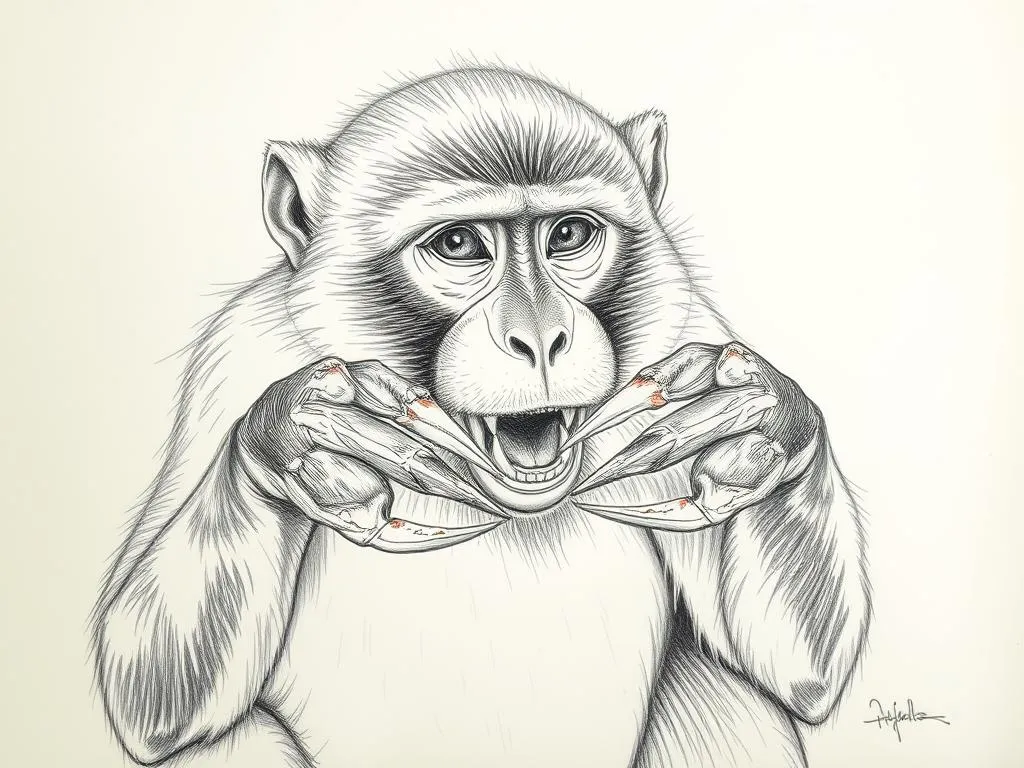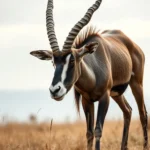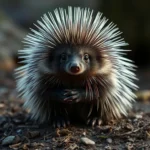The Intriguing Symbolism of the Crab-Eating Macaque

Disclaimer: Some images on this website are AI-generated artworks and may not accurately represent real animals.
The crab-eating macaque (Macaca fascicularis), known for its adaptability and social nature, holds significant symbolism and meaning across various cultures. This blog post delves into the multifaceted aspects of this fascinating primate, from its biological characteristics to its rich symbolic interpretations.
Understanding the Crab-Eating Macaque
Taxonomy and Habitat
The crab-eating macaque belongs to the family Cercopithecidae. Scientifically classified as Macaca fascicularis, it finds its home across Southeast Asia, including countries like Thailand, Malaysia, and Indonesia.
Natural Habitat and Distribution
These primates thrive in diverse environments, primarily residing in coastal areas, mangroves, and even urban locales. Their ability to adapt to different habitats showcases their resilience and flexibility, traits that resonate deeply with their symbolic meanings.
Social Structure and Behavior
Crab-eating macaques are highly social animals, living in troops that can consist of up to 50 individuals. Their social structure is matriarchal, with females often holding higher social standings. This intricate social web allows for cooperative behaviors, such as foraging and grooming, which strengthen their bonds.
Unique Characteristics
Diet and Foraging Behavior
As their name suggests, crab-eating macaques have a diverse diet that includes crabs, fruits, and other vegetation. Their foraging behavior is remarkable; they often use tools to extract food from hard-to-reach places, demonstrating their intelligence and adaptability.
Physical Traits and Adaptations
| Physical Trait | Description |
|---|---|
| Size | Medium-sized primate, 40-65 cm long |
| Weight | 5-10 kg |
| Fur Color | Light brown with darker patches |
| Facial Features | Prominent snout, expressive eyes |
| Tail | Short, often not visible |
These physical characteristics equip the crab-eating macaque for survival in varied environments, enhancing its symbolism as a creature of adaptability.
Intelligence and Problem-Solving Skills
The intelligence of the crab-eating macaque is noteworthy. They display advanced problem-solving skills, often working cooperatively to overcome challenges, which further solidifies their representation of adaptability and resourcefulness.

Symbolism & Spiritual Meaning
Adaptability and Resourcefulness
One of the most prominent symbols associated with the crab-eating macaque is adaptability. Their varied diet, which includes crabs, fruits, and insects, exemplifies their resourcefulness. This adaptability teaches us valuable lessons about utilizing available resources in our own lives.
In a world that is constantly changing, the crab-eating macaque reminds us to remain flexible and open-minded, adapting to circumstances rather than resisting them.
Community and Social Bonds
The significance of community among crab-eating macaques cannot be overstated. Their social structures emphasize teamwork and cooperation. In a troop, every member plays a role, whether in foraging, protecting the young, or grooming each other.
This communal spirit symbolizes the importance of social bonds in human life. It highlights the need for collaboration and support systems in overcoming challenges, reinforcing the idea that we are stronger together.
Playfulness and Curiosity
Crab-eating macaques are also known for their playful nature. Their curiosity leads them to explore their surroundings, engage in playful behaviors, and interact with their peers. This representation of joy and exploration encourages us to embrace the playful moments in life, reminding us that curiosity can lead to growth and new experiences.
Crab-Eating Macaque in Dreams
Common Themes and Interpretations
Dreaming of crab-eating macaques can signify various themes. Often, these dreams reflect adaptability and social interactions, serving as reminders to embrace change and nurture our relationships.
| Dream Theme | Interpretation |
|---|---|
| Encountering macaques | Embracing social connections |
| Playful macaques | Encouragement to seek joy and fun |
| Struggling macaques | Indication of feeling overwhelmed |
| Resourceful macaques | Reminder to tap into inner strengths |
These themes can provide insights into our subconscious, encouraging reflection on our adaptability and the importance of our social networks.
Personal Growth and Transformation
When the crab-eating macaque appears in dreams, it can signify personal growth and transformation. This encounter often urges individuals to reflect on their resourcefulness and adaptability in real life. It serves as a reminder that embracing change and utilizing available resources can lead to significant personal evolution.
Modern Interpretations
Cultural Significance
The crab-eating macaque holds a place in various cultural narratives, often depicted in folklore and mythology. In some cultures, they are seen as tricksters, embodying cleverness and adaptability. These traits resonate with their behavior in the wild, where they outsmart challenges in their environment.
In contemporary art and literature, the crab-eating macaque symbolizes broader themes of resourcefulness and social connection. Artists and writers may use this primate to represent the balance between individuality and community, highlighting the importance of staying connected while navigating life’s challenges.
Environmental Awareness
The role of the crab-eating macaque extends beyond cultural symbolism into the realm of environmental awareness. As discussions about biodiversity and habitat loss intensify, these primates serve as a symbol of resilience. Their presence in various ecosystems emphasizes the importance of preserving biodiversity and maintaining the delicate balance of nature.
By studying the behaviors and habitats of crab-eating macaques, we can better understand the impacts of human activity on wildlife and ecosystems. This awareness can inspire action toward conservation efforts, reminding us that every species plays a crucial role in the environment.
Key Takeaways
- The crab-eating macaque symbolizes adaptability and resourcefulness, serving as a reminder to embrace change.
- Their strong social bonds underline the importance of community, teamwork, and support systems.
- The playful nature of these macaques encourages us to find joy and curiosity in everyday life.
- Dream encounters with crab-eating macaques may reflect personal growth and adaptability in real life.
- In modern culture, they represent the balance between individuality and community, while also highlighting environmental awareness.
Conclusion
The crab-eating macaque is not only a fascinating creature but also a powerful symbol of qualities we can embody in our daily lives. From adaptability and resourcefulness to strong social bonds and a curious spirit, these traits can guide us as we navigate the complexities of life. By embracing the essence of this remarkable primate, we can cultivate a deeper connection with ourselves and the world around us. The crab-eating macaque serves as a reminder that in the face of challenges, we can find strength in our adaptability, joy in our curiosity, and support in our communities.







